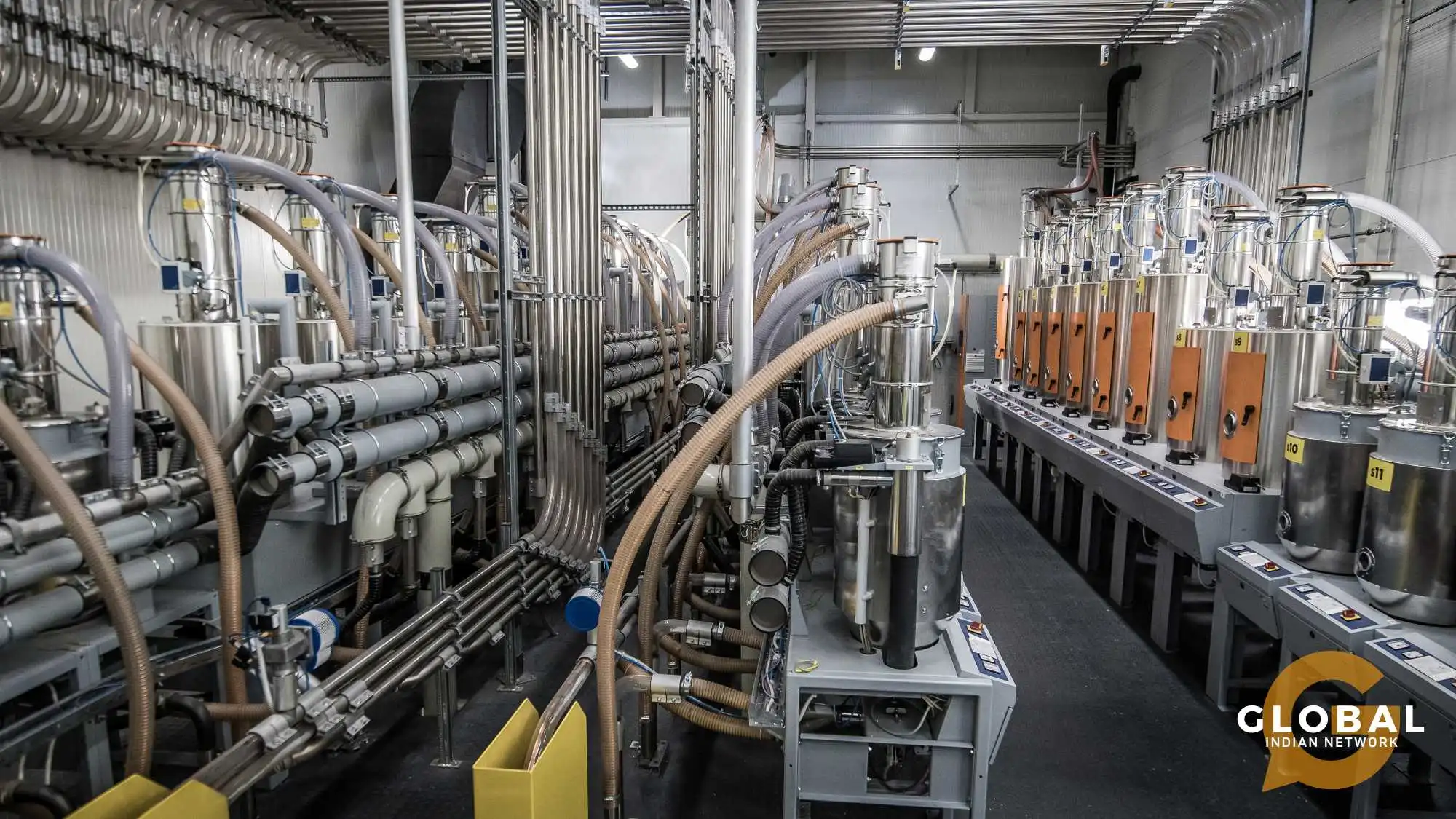India's global economic integration has led to substantial growth despite a contraction in real GDP in FY20/21 due to the COVID-19 pandemic. India's economy comprises agriculture, manufacturing, and a rapidly growing service sector, with rice, wheat, and cotton being major crops that employ a significant portion of the workforce. Between 2011 and 2019, India reduced extreme poverty by half, but the pace has slowed, particularly during the COVID-19 pandemic. India aims to achieve high-income status by 2047, marking its centenary of independence while also addressing climate change challenges and achieving net-zero emissions by 2070.
Table of Contents
Exports of goods and services (% of GDP) in India were reported at 22.79 % in 2022, the World Bank collection of development indicators, compiled from officially recognised sources. India - Exports of goods and services (% of GDP) - actual values, historical data, forecasts and projections
Indian import and export with the world - Timeline
Contribution of the Manufacturing Sector to GDP Growth
The manufacturing sector, which contributes significantly to GDP growth in countries like India, comprises various industries such as textiles, pharmaceuticals, automobiles, and consumer durables, employing a significant portion of the workforce and accounting for 15%-17% of the nation's GDP.
India aims to boost manufacturing's share in GDP from 17% to 25% as part of a strategy to boost economic growth and create jobs. The government has implemented reforms and policies, including the Performance-linked Incentives scheme, which has significantly increased FDI in the manufacturing sector.
Manufacturing contributes to 16% of global GDP and 14% of employment, with figures varying based on a country's development stage. As countries grow, the manufacturing sector often becomes a larger part of the economy.
Manufacturing Purchasing Managers' Index (PMI)
The Manufacturing Purchasing Managers’ Index (PMI) index serves as an essential indicator of the economic health of the manufacturing sector. It is based on five major indicators: new orders, inventory levels, production, supplier deliveries, and the employment environment. In the Purchasing Managers' Index (PMI) parlance, a print above 50 means expansion, while a score below 50 denotes contraction.
Manufacturing PMI in India increased to 59.10 points in March from 56.90 points in February of 2024. Manufacturing PMI in India averaged 52.75 points from 2012 until 2024, reaching an all-time high of 59.10 points in March of 2024 and a record low of 27.40 points in April of 2020. This page provides the latest reported value for - India Manufacturing PMI - plus previous releases, historical high and low, short-term forecast and long-term prediction, economic calendar, survey consensus and news. India Manufacturing PMI - data, historical chart, forecasts and calendar of releases - was last updated in April of 2024.
In March 2024, the HSBC India Manufacturing PMI was revised lower to 59.1 from preliminary estimates of 59.2. Although slightly below forecasts of 59.4, this reading represents the fastest growth in factory activity since February 2008. Notably, both output and new orders experienced robust growth, with new export orders rising significantly. Additionally:
- Buying levels surged to the fastest rate since mid-2023.
- Employment climbed to the strongest level since September 2023.
- Vendor performance improved.
- Input price inflation accelerated due to higher raw material costs.
- Output cost inflation eased to the weakest level in over a year.
- Business sentiment slipped to a four-month low due to concerns about inflation.
In summary, India’s manufacturing sector has shown remarkable resilience and growth despite challenges related to inflation and supply chain dynamics.
You Might Be Interested In: Business Potential of India’s Logistics Industry in 2024
Key Industries Within India's Manufacturing Sector
India's manufacturing sector is diverse and contributes significantly to the country's economic growth. Here are some key industries within this sector:
Automotive Industry: India is a significant automobile manufacturing hub, producing cars, motorcycles, commercial vehicles, and components, with leading global automakers establishing production facilities in the country.
Textile and Apparel Industry: India is a global leader in textile and garment production, exporting clothing, accessories, and other products made from cotton, silk, wool, and synthetic fibres.
Pharmaceutical Industry: India is a significant player in generic drug manufacturing, providing medicines globally, and its pharmaceutical sector also encompasses research and development.
Consumer Electronics and Appliances: India's "Make in India" initiative has significantly boosted the country's electronics manufacturing industry, resulting in the production of various consumer electronics.
Construction Materials and Cement: The construction industry in India heavily relies on cement and steel due to its infrastructure development.
Rubber and Plastic Products: The rubber and plastic industries, which produce tyres, hoses, and packaging materials, contribute to both domestic consumption and exports.
Machinery and Equipment Manufacturing: India is a leading producer of machinery, industrial equipment, and tools, encompassing sectors such as machine tools, industrial automation, and heavy machinery.
Metal and Metallurgical Industries: India's manufacturing sector is largely dominated by steel production, alongside the production of aluminium, copper, and other metals.
Chemical and Petrochemical Industry: India is a major producer of chemicals, petrochemicals, and fertilisers, which are crucial in agriculture, industrial processes, and healthcare.
Food and Beverages: India's growing population relies heavily on the food processing and beverage industries, which encompass dairy products and packaged foods.
Remember that these industries collectively contribute to India's economic vibrancy and provide employment opportunities for millions.
The Labour Force in the Manufacturing Sector in India
Challenges Faced by the Manufacturing Sector in India
The manufacturing sector in India grapples with several challenges that impact its growth and competitiveness. Let's explore these challenges:
Infrastructure Deficit: India faces significant infrastructure gaps in transportation, energy, and communication, which hinder efficient production and distribution despite progress made.
Skilled Labor Shortage: The scarcity of skilled workers remains a significant issue, necessitating the implementation of training and education to ensure continuous growth.
Credit Accessibility: Manufacturers frequently face challenges in securing credit for expansion, modernisation, and working capital, making affordable credit essential for sector development.
Global Demand Slowdown: The manufacturing sector is influenced by global demand fluctuations, economic slowdowns, and geopolitical factors, which impact exports and overall growth.
Competition from China and Other Nations: India faces fierce competition from China, necessitating Indian manufacturers to improve efficiency and product quality to remain competitive.
Regulatory Challenges: The complexity of labour laws, land acquisition processes, and regulatory compliance can hinder business operations, and streamlining these regulations can enhance efficiency.
Costly Transportation: India faces high transportation costs compared to developed nations, necessitating efficient logistics and supply chain management.
Underperformance Relative to GDP: Indian manufacturing, despite abundant low-skilled labour, remains capital and skill-intensive, with firms often remaining small to avoid taxes and complex labour regulations.
Investment Crisis: India is facing a significant investment and consumption crisis due to a combination of regulatory issues, unfavourable land and labour laws, and inadequate connectivity.
Balancing Growth and Competitiveness: Slow growth could render India non-competitive, so the pace of manufacturing infrastructure development must match demand growth.
In summary, addressing these challenges requires strategic policy interventions, investment in infrastructure, and fostering a skilled workforce to propel India's manufacturing sector forward.
Successful High-Value Manufacturing in India
Here are some examples of successful high-value manufacturing in India:
Tata Motors Ltd: Tata Motors is one of the biggest manufacturers in India. They have produced high-value cars and used technology to drive innovation, making notable advancements in the automotive sector.
Tata Steel Limited: Tata Steel is a significant participant in the steel sector. Their success in high-value manufacturing can be attributed to their emphasis on efficiency, quality, and sustainable practices.
Hindalco Industries Ltd: The leading manufacturer of aluminium is Hindalco. Their dedication to cutting-edge procedures and high-value goods has given them a strong competitive advantage.
Mahindra & Mahindra Ltd: The company Mahindra & Mahindra is well-known for producing tractors and other farming machinery. Their success in high-value manufacturing can be attributed to their emphasis on quality and customer satisfaction.
Maruti Suzuki India Ltd: Maruti Suzuki is one of the leading automakers. They are a market leader in the Indian automobile industry thanks to their effective production methods and attention to customer needs.
These companies exemplify how high-value manufacturing can drive growth, create jobs, and contribute to India's economic development.
Indian Government Support for Small and Medium Enterprises
The Indian government has implemented several initiatives to support Micro, Small & Medium Enterprises (MSMEs) in the country. Here are some notable measures:
Emergency Credit Line Guarantee Scheme (ECLGS): This scheme provides Rs. 5 lakh crore in credit guarantees for businesses, including MSMEs, to help them during challenging times.
Equity Infusion through MSME Self-Reliant India Fund: The government has infused Rs. 50,000 crore into the MSME sector through this fund.
Revised Criteria for Classification of MSMEs: The criteria for classifying MSMEs have been updated to better align with their actual size and operations.
Make in India Program: Efforts under the Make in India program aim to enhance exports by MSMEs.
Promotion of Ease of Doing Business: Initiatives have been taken to simplify processes and create a business-friendly environment for MSMEs.
MUDRA (Micro Units Development and Refinance Agency) Loans: These loans provide improved access to credit for MSMEs.
Together with relevant Ministries, State Governments, and other stakeholders, these actions support the expansion and development of the thriving MSME sector, which includes Khadi, Village, and Coir Industries. The government's priorities are boosting entrepreneurship, bolstering the rural economy, and assisting already-existing businesses as well as promoting the establishment of new ones.
Emerging Trends in the Manufacturing Sector
Let’s delve into the emerging trends in the manufacturing sector in India:
Supply Chain Resilience: The COVID-19 pandemic exposed global supply chain vulnerabilities, prompting companies to reconfigure their sourcing and manufacturing footprints, with India as a potential manufacturing powerhouse leveraging this opportunity to strengthen its supply chain networks.
Growth Potential: From 2006 to 2012, India's manufacturing sector GDP grew at an average of 9.5% per year but declined to 7.4% in the following six years. To fully realise its potential, India should focus on globally competitive manufacturing hubs that utilise India's raw materials, skills, and entrepreneurship.
Value Chains: Eleven manufacturing value chains in India have significant potential for international markets, growth, and job creation. By leveraging India's strengths, they can capitalise on export opportunities, import localisation, domestic demand, and contract manufacturing. A fresh industrial policy could double their GDP contribution to $500 billion within seven years.
Technology-Driven Transformation: Traditional companies are undergoing rapid transformation due to trends like off-shoring to on-shoring and mass manufacturing to mass customisation, with robotics and automation playing a crucial role.
Attractive Destination: India is gaining popularity as a global manufacturing hub due to its skilled labour, cost competitiveness, and growing consumer market.
Technological Advancements: Technological advancements, including industrial automation, 3D printing, and cloud manufacturing, are driving growth in the manufacturing sector worldwide
Safety Measures: Ensuring safety in manufacturing processes is essential. Proactive measures are necessary to foster secure and efficient manufacturing practices in India.
India has the potential to enhance its manufacturing sector by leveraging its strengths, embracing technology, and adopting strategic policies, which can drive economic growth, create jobs, and significantly contribute to the global manufacturing landscape.
Addressing Labour Shortages
India's manufacturing sector, comprising industries like textiles, pharmaceuticals, automobiles, and consumer durables, contributes 15% of the country's GDP and employs 12% of the workforce, significantly boosting economic growth.
However, the manufacturing sector in India faces several challenges, including skilled labour shortages. Let’s delve into the growth drivers and potential solutions.
Growth Drivers
Increased Investment: The government has allocated funds to promote electronics and IT hardware manufacturing, as well as the adoption of hybrid and electric vehicles.
Competitiveness: India's global competitiveness is bolstered by its semi-skilled labour force, "Make in India" initiatives, substantial investments, and a large domestic market.
Robust Demand: India's middle class is projected to hold the second-largest share in global consumption by 2030.
Challenges Related to Skilled Labour Shortages
Lack of Trained and Skilled Labor: The scarcity of skilled workers limits sector growth.
Complex Regulations: Burdensome regulations (such as licensing and audits) can hinder businesses.
Poor Supply Chain: Challenges in supply chain management affect efficiency.
Addressing the Labour Shortage
Mentoring Programs: Companies can assign mentors to new employees.
Contract Workers: Hiring third-party contract workers can help bridge the gap.
Image source: www.statesman.com
Collaboration with Educational Institutions: Partnering with technical or community colleges can enhance skill development.
Gender Diversity: Proactively recruiting women can contribute to a more diverse workforce.
In conclusion, sustainable reforms and collaborative efforts are essential to unlock the full potential of India’s manufacturing sector and address labour shortages effectively.
Net-Zero Emissions Goals
Sustainable fashion
The purpose of economic growth is justified only if the development is made considering the finite resources of the Earth. As per climate agreements made over the years, India should take the sustainability route to attain its goals.
Over 100 decarbonisation levers have been proposed across critical sectors, with four cross-cutting opportunities being explored: Green Hydrogen, Carbon Capture, Usage, and Storage (CCUS), Natural Climate Solutions, and Material Circularity, which aim to promote sustainable decarbonisation through renewable hydrogen production, carbon absorption, and circular economy practices.
India's net-zero journey can be modelled in two scenarios: current LoS scenario, where emissions could be reduced from 11.8 GtCO₂e to 1.9 GtCO₂e by 2070, and accelerated scenario, where policies like carbon pricing and technology adoption could help reach 0.4 GtCO₂e by 2050, paving the way for a net-zero commitment by 2070, requiring actions like increasing renewable capacity, reducing battery costs, and adopting circularity targets.
India aims to increase non-fossil energy capacity to 500 GW by 2030, meet 50% of energy requirements from renewable sources, and reduce the economy's carbon intensity by 45%.
To achieve success, several actions are needed, including increasing renewable capacity from 10 GW to 40-50 GW, reducing hydrogen costs by 50% by 2030, reducing battery and green hydrogen costs by 40% by 2030, implementing nationwide EV charging infrastructure, encouraging sustainable rice cultivation practices among farmers, and setting higher circularity targets for material circularity.
India aims to achieve net-zero emissions by 2070 to combat climate change. Despite low per-capita emissions, India is the third-largest emitter globally, releasing 2.9 gigatons of carbon dioxide equivalent annually as of 2019. The majority of these emissions come from six key sectors: power, steel, automotive, aviation, cement, and agriculture. India's commitment to create 287 gigatons of carbon space, nearly half of the global carbon budget, demonstrates its commitment to sustainable growth and climate action.
You Might Be Interested In: Business Potential of India’s Logistics Industry in 2024
Conclusion
India's manufacturing sector, currently contributing 17% to GDP, aims to increase to 25% by 2026-27, aligning with the country's $5 trillion economy goal. Key sectors include automotive/EVs, FMCG/CPG, chemicals, life sciences, MMC, semiconductors, mobile devices, and data centres.
Foreign manufacturers are expanding their operations in India through equity joint ventures, strategic alliances, or subsidiaries, primarily operating in sectors like automotive, engineering, chemicals, pharmaceuticals, and consumer durables. India's manufacturing sector experienced a 16-year high in March 2024, driven by the strongest increase in output and new orders since October 2020. The manufacturing market is projected to have around 244,400 enterprises by 2024, with an estimated 18.22 million employees.
The world’s GDP is $100 trillion today, while India's digitisation is only 25 percent, and the consumer sector is $20 trillion. What has to be digitised is the industrial sector, which is $75 trillion. That opportunity may well be India’s opportunity because we need to make two-wheelers, cars and tractors, because those physical products will never become digital. Entrepreneurs have to come into the picture as the global race gets tougher by the day.











[…] summary, while the manufacturing sector is essential to Slovenia's economy, it's crucial to consider the broader context of domestic […]